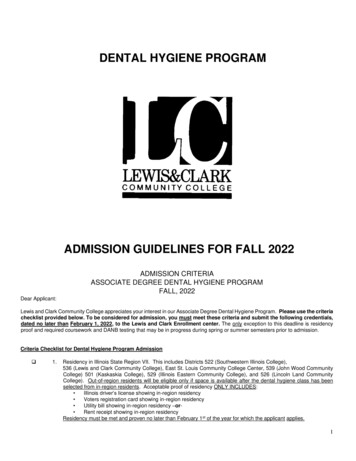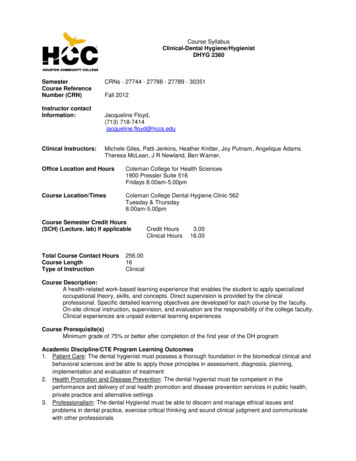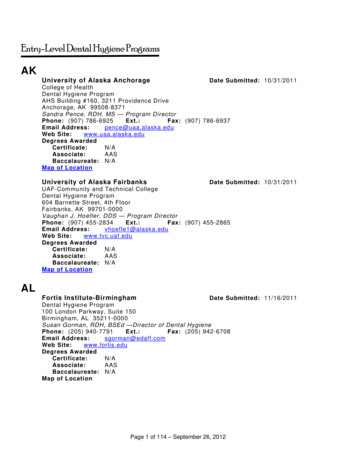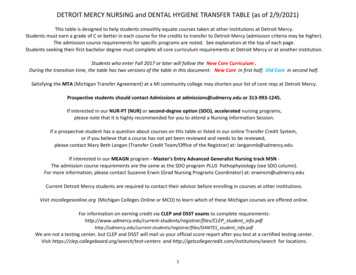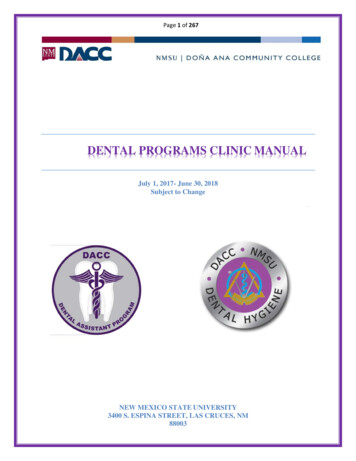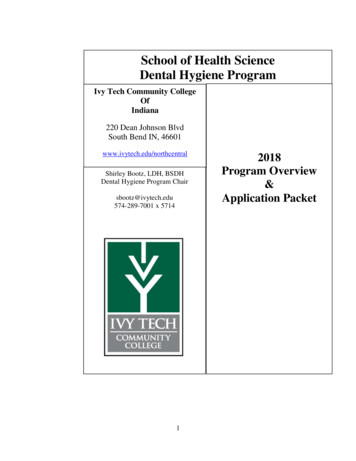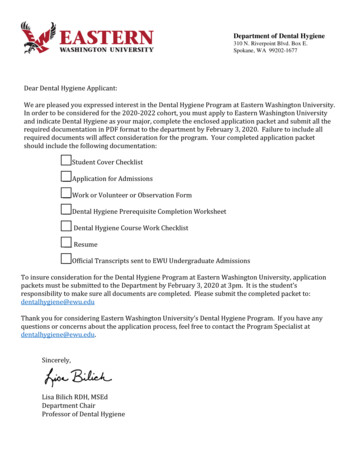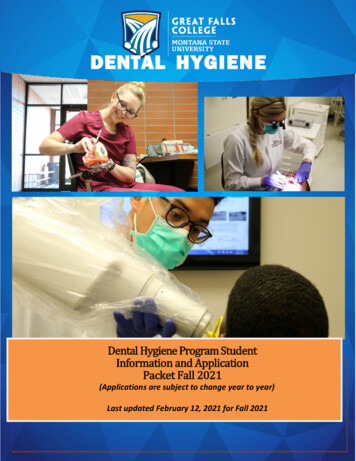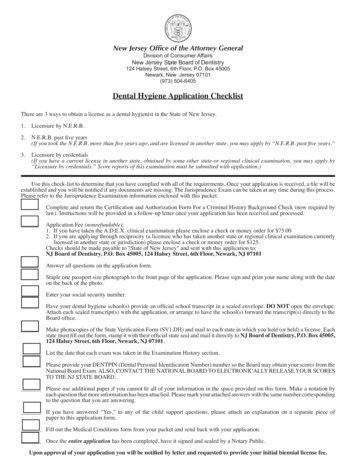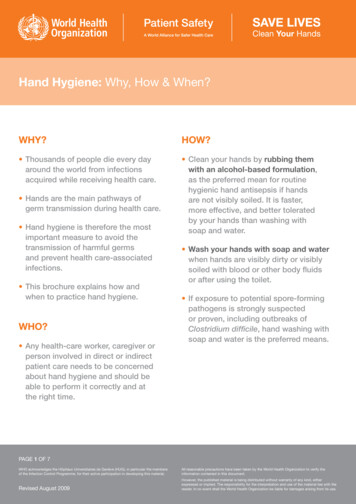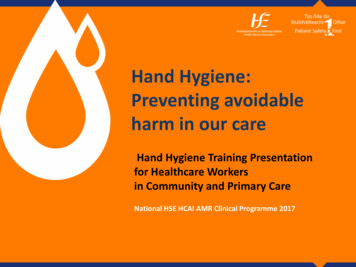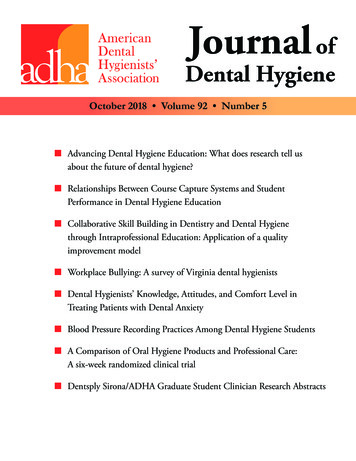
Transcription
Journal ofDental HygieneOctober 2018 Volume 92 Number 5 Advancing Dental Hygiene Education: What does research tell usabout the future of dental hygiene? Relationships Between Course Capture Systems and StudentPerformance in Dental Hygiene Education Collaborative Skill Building in Dentistry and Dental Hygienethrough Intraprofessional Education: Application of a qualityimprovement model Workplace Bullying: A survey of Virginia dental hygienists Dental Hygienists’ Knowledge, Attitudes, and Comfort Level inTreating Patients with Dental Anxiety Blood Pressure Recording Practices Among Dental Hygiene Students A Comparison of Oral Hygiene Products and Professional Care:A six-week randomized clinical trial Dentsply Sirona/ADHA Graduate Student Clinician Research Abstracts
Journal of Dental HygieneOctober 2018 Volume 92 Volume 5Statement of Purpose2018 – 19 ADHA OfficersThe Journal of Dental Hygiene is the refereed, scientificpublication of the American Dental Hygienists’ Association.The JDH promotes the publication of original researchrelated to the profession, education, and practice of dentalhygiene and supports the development and disseminationof a dental hygiene body of knowledge through scientificinquiry in basic, applied and clinical research.PresidentMichelle Braerman, RDH, BSDHTreasurerDonnella Miller, RDH, BS, MPSPresident ElectMatt Crespin, RDH, MPHImmediate Past PresidentTammy Filipiak, RDH, MSVice PresidentLisa Moravec, RDH, MSSubsciptionsADHA/JDH StaffThe Journal of Dental Hygiene is published bi-monthlyonline by the American Dental Hygienists’ Association,444 N. Michigan Avenue, Chicago, IL 60611. Copyright2018 by the American Dental Hygienists’ Association.Reproduction in whole or part without written permissionis prohibited. Subscription rates for non-members are oneyear, 60.SubmissionsAuthor guidelines and the manuscript submission process canbe found at: http://www.adha.org/resources-docs/7833 JDHAuthor Guidelines.pdfEditor–In–ChiefRebecca S. Wilder, RDH, MSrebeccaw@adha.netChief Operating OfficerBob Moore, MA, CAEbobm@adha.netManaging EditorCatherine K. Draper, RDH, MScathyd@adha.netCo-Director ofProfessional Development &Member EngagementSue Bessnersueb@adha.netEditor EmeritusMary Alice Gaston, RDH, MSChief Executive OfficerAnn Battrell, MSDHannb@adha.netLayout/DesignDorreen Petersen Davis, MSEditorial Review BoardCeleste M. Abraham, DDS, MSCynthia C. Amyot, RDH, EdDRoland R. Arnold, PhDJoanna Asadoorian, RDH, PhDKathryn Bell, RDH, MSKristy Menage Bernie, RDH, MSStephanie Bossenberger, RDH, MSDenise Bowen, RDH, MSLinda D. Boyd, RDH, RD, EdDJennie Brame, RDH, MSKimberly S. Bray, RDH, MSAnn Bruhn, BSDH, MSLorraine Brockmann, RDH, MSPatricia Regener Campbell, RDH, MSAubree Chismark, RDH, MSLorinda Coan, RDH, MSMarie Collins, EdD, RDHSharon Compton, RDH, PhDAmy E. Coplen, RDH, MSElizabeth T. Couch, RDH, MSSusan J. Daniel, RDH, MSKathy Eklund, RDH, MHPMelissa Efurd, RDH, MSDH, EdDDeborah E. Fleming, RDH, MSPriscilla Flynn, RDH, MPH, PhDJane L. Forrest, RDH, MS, EdDJacquelyn L. Fried, RDH, MSDanielle Furgeson, RDH, MS, DHScJoan Gluch, RDH, PhDMaria Perno Goldie, RDH, MSEllen B. Grimes, RDH, MA, MPA, EdDTami Grzesikowski, RDH, MEdJoAnn R. Gurenlian, RDH, PhDLinda Hanlon, RDH, MEd, PhDMelanie J. Hayes, BOH, BHSc, PhDRachel Kearney, RDH, MSHarold Henson, RDH, MEd, PhDKathleen Hodges, RDH, MSAlice M. Horowitz, RDH, PhDJanet Kinney, RDH, MSElizabeth C. Kornegay, CDA, RDH, MSDHDeborah Lyle, RDH, BS, MSLisa F. Harper Mallonee, BSDH, MPH, RD/LDDeborah S. Manne, RDH, RN, MSN, OCNSally M. Mauriello, RDH, EdDTanya Villalpando Mitchell, RDH, MSTricia Moore, RDH, EdDChristine Nathe, RDH, MSJodi Olmsted, RDH, PhDPamela Overman, RDH, MS, EdDBrian Partido, RDH, MSCeib Phillips, MPH, PhDLori Rainchuso, RDH, DHScDorothy J. Rowe, RDH, MS, PhDTammy R. Sanderson, RDH, MSCynthia F. Sensabaugh, RDH, MSMelanie Simmer-Beck, RDH, PhDDeanne Shuman, BSDH, MS PhDAnn Eshenaur Spolarich, RDH, PhDRebecca Stolberg, RDH, MSDHJulie Sutton, RDH, MSSheryl L. Ernest Syme, RDH, MSTerri Tilliss, RDH, PhDLynn Tolle, BSDH, MSBethany Valachi, PT, MS, CEASMarsha A. Voelker, CDA, RDH, MSDonna Warren-Morris, RDH, MEdCheryl Westphal Thiele, RDH, MS, EdDKaren B. Williams, RDH, MS, PhDTim Wright, DDS, MSPamela Zarkowski, BSDH, MPH, JD
Inside this IssueGuest Editoial4Advancing Dental Hygiene Education: What does research tell us about thefuture of dental hygiene?Colleen M. Brickle, RDH, EdDInnovations in Education and Technology6Relationships Between Course Capture Systems and Student Performancein Dental Hygiene EducationCarly J. Havner, RDH, MS; Mary M. Gerkovich, PhD; Kimberly K. Bray, RDH, MS;Marsha A. Voelker, CDA, RDH, MS14Collaborative Skill Building in Dentistry and Dental Hygiene throughIntraprofessional Education: Application of a quality improvement modelTricia S. Barker, RDH, MEd; Chet A. Smith, DDS; Geri M. Waguespack, RDH, MS;Donald E. Mercante, PhD; Tina P. Gunaldo, PhD, DPT, MHSResearch22Workplace Bullying: A survey of Virginia dental hygienistsGayle B. McCombs, RDH, MS; S. Lynn Tolle, RDH, MS; Tara L. Newcomb, RDH,MS; Ann M. Bruhn, RDH, MS; Amber W. Hunt, RDH, MS; Lanah K. Stafford, MA30Dental Hygienists’ Knowledge, Attitudes, and Comfort Level inTreating Patients with Dental AnxietyLauren Kanzigg, RDH, MS; Ceib L. Phillips, PhD; Margot B. Stein, PhD;Lynne C. Hunt, RDH, MEd, MS; Rebecca S. Wilder, RDH, MS38Blood Pressure Recording Practices Among Dental Hygiene StudentsJulie D. Sutton, RDH, MS; Sally A. Elledge, RDH, MS; JoAnna M. Scott, PhD;Chris D. Rice, DDS, EdS45A Comparison of Oral Hygiene Products and Professional Care:A six-week randomized clinical trialCristina E. Garcia-Godoy, DDS, MPH; Kevin L. Flores, BS, MPH; Malgorzata A.Klukowska, DDS, PhD; Erinn L. Conde, BS; Robert W. Gerlach, DDS, MPH52Dentsply Sirona/ADHA Graduate Student Clinician Research Abstracts fromthe 2018 Annual Conference of the American Dental Hygienists’ AssociationThe Journal of Dental Hygiene3Vol. 92 No. 5 October 2018
Guest EditorialAdvancing Dental Hygiene Education: What doesresearch tell us about the future of dental hygiene?Colleen M. Brickle, RDH, EdDIn June of this year, Rutgers University held a workshop,inviting researchers for the project “Advancing DentalEducation: Gies in the 21 Century.” The project consistedof two phases. In phase one, background papers focusing onthe trends that will determine the future direction of dentaleducation were written and published.1, 2 Phase two consistedof the workshop where participants reviewed the publishedpapers and made recommendations to address the issuesand challenges in dental education over the next 25 years.A common theme voiced throughout the workshop was fordental education to be innovative and responsive to currentand new workforce models in order to meet the demands ofall populations seeking oral health care.Minnesota has a reputation for developing andimplementing innovative and creative ways to meet thedemands of a prepared and competent dental workforce. In1969 Minnesota was the first state to mandate continuingeducation requirements to maintain licensure.3 In 2001,Minnesota was the third state to expand access to care byallowing dental hygienists to provide dental hygiene carebeyond the traditional, brick and mortar practice setting.4Then in 2009, Minnesota was the first state to authorize thelicensure of dental therapists and certification of advanceddental therapists.5Minnesota has not been resting on its laurels. In 2012,dedicated educators and administrators designed an innovativeapproach to move baccalaureate education forward as theentry level for dental hygiene. More than forty years ago, theAmerican Dental Hygienists’ Association advocated elevatingthe profession with the baccalaureate degree as the entrylevel for dental hygienists.6 The American Dental EducationAssociation also published a brief on expanding dentalhygiene pathways toward a bachelor degree.7 In reality, themajority of dental hygiene associate degree programs alreadyapproach a minimum of three years due to the requiredprerequisite courses necessary to meet the Commission onDental Accreditation standards.The Journal of Dental HygieneAssociate degree graduates (AA/AAS) are seeking seamlesspathways to a bachelor degree. However, most importantly,baccalaureate education is necessary for dental hygienists tomeet the oral health care needs of all populations in the 21stcentury, especially for our vulnerable populations.7 In order tomeet the needs of these populations, dental hygiene programsmust prepare students to deliver care in settings beyondclinical private practice. Today’s oral health care professionalsneed higher-level order of problem-solving skills to be ableto think critically while applying evidence to inform practice.Meeting this challenge as well as the other competencies suchas health literacy, cultural sensitivity, community-based and/orinterprofessional practice, by simply adding more content toan already crowded associate degree curriculum, is not possible.The most recent innovative education pathway fromMinnesota is the option of a dual admissions and enrollmentprogram.8 In addition to Minnesota, Texas has developed asimilar model of dual admissions at Texas Women’s University.9How does dual enrollment work in Minnesota? Studentsadmitted and enrolled in an AS/AAS dental hygiene programcan begin to take upper division courses simultaneously toobtain a bachelor degree in dental hygiene (BSDH). Thiscreative and seamless pathway allows a student to graduatewith an AA/AAS degree from a community or technicalcollege and a bachelor’s degree simultaneously or within asemester of completing the AA/AAS degree.Students admitted to Normandale Community College’sassociate dental hygiene program are enthusiastic about theopportunity to dual enroll at Metropolitan State University.Testimonials from students show that this curriculum modelis achievable and prepares students for practicing in settingsoutside of private practice. Licensed dental hygienists seekinga BSDH as part of the degree completion program enrollin the core upper division dental hygiene courses with theassociate students. An unexpected outcome of this programhas been the mentorship and guidance provided by licenseddental hygienists.4Vol. 92 No. 5 October 2018
The BSDH courses are delivered online and easily fitschedules. The coursework is individualized and paced toencourage student success. The bachelor curriculum contentincludes such topics as project management, leadership, business planning, team-based care, health equity, interprofessionalcollaboration and public health. Students find the BSDH degreea gateway to further study by offering a direct path to a master’sdegree in dental therapy, education, business public health,dental therapy and other education or career opportunities.4.Minnesota statutes 150A.10 subdivision 1. df.5.Minnesota es/cite/150A.1056.American Dental Hygienists’ Association. Policy manual[Internet]. Chicago: American Dental Hygienists’ Association; 2018 [cited 2018 Oct 1] Available from: http://www.adha.org/resources-docs/7614 Policy Manual.pdf.Higher education views this model as a win-win forstudents and the institutions. Community colleges can countthe associate degree graduates in their completion totals andthe university can count the baccalaureate degree graduatesin their completion totals. Funding from Delta Dentalof Minnesota Foundation along with a Health Resourcesand Services Administration (HRSA) workforce grant hasallowed for Normandale Community College to expand dualadmissions and enrollment to include four other AA/AASdegree programs in dental hygiene in the state of Minnesota.7.American Dental Education Association. Bracing for theFuture: opening up pathways to the bachelor’s degreefor dental hygienists. ADEA and the institute for highereducation policy, 2011 [Internet]. Washington,DC:American Dental Education Association; 2018 [cited1 Oct 2018]. Available from: https://www.adea.org/policy advocacy/workforce issues/Pages/default.aspx8.Sidd, DJ. The journey to opportunity. Dimens DentHyg. 2017 Apr;15 (4):16-17.9.Texas Woman’s University. Dual admissions dental hygiene[Internet] Denton: Texas Woman’s University; 2018[cited2018 Oct 1]. Available from: ment-dental-hygiene/Constant communication and collaboration betweeninstitutions is the key to success when developing an innovativeeducational pathway such as the dual enrollment programs inMinnesota and Texas.10 Successful programs take commitmentand dedication for the long haul and challenges will occur!Dental hygiene educators throughout Minnesota believestrongly that graduates need to be well prepared not onlyfor traditional private practice settings but also for emergingpractice settings in order to meet the needs of all populations.10. American Dental Hygienists’ Association. Educationpartnership: associate to bachelor. Access [Internet]. 2017Aug [cited 1 Oct]; 31(7):7-8. Available from: http://pubs.royle.com/publication/?i 432204&ver html5&p 19.For additional information and resources on dualadmissions /enrollment as well as other innovative initiativesin Minnesota, access the Normandale Community College’ssignature website, “Minnesota 21st Century Dental Team atwww.normandale.edu/mndentalteam.Colleen M. Brickle, RDH, EdD is the Dean, Departmentof Health Sciences at Normandale Community College,Bloomington, MN.References1.Balit, HL, Formicola, AJ. Advancing dental education inthe 21st century. J Dent Educ, 2017 Aug; 81 (8):1004-32.2.Fried, JL. The allied professions: executive summary. JDent Educ. 2017 Sept; 81 (9):1130-363.McDonnell, RE. The Minnesota experience: implementing mandatory continuing education. J Am DentAsso. 1976 Jun;92 (6):1218-24.The Journal of Dental Hygiene5Vol. 92 No. 5 October 2018
Innovations in Education and TechnologyRelationships Between Course Capture Systems and StudentPerformance in Dental Hygiene EducationCarly J. Havner, RDH, MS; Mary M. Gerkovich, PhD; Kimberly K. Bray, RDH, MS;Marsha A. Voelker, CDA, RDH, MSAbstractPurpose: The aim of this mixed-methods longitudinal study was to assess student perceptions of technology use, and toexamine the relationship between technology use and performance as reflected by self-reported student grade point averages.Methods: Students (n 351) enrolled in a dental hygiene program within a dental school located in the mid-western UnitedStates were surveyed in three courses from 2008 through 2012 to gather their perceptions regarding usage of a lecturerecording system (LRS). Additionally, self-reported grade point averages were collected over the same period of time. Datawere analyzed using a statistical software program (IBM SPSS; Armonk, NY).Results: The response rate was 82%. Descriptive statistics demonstrated that students believed that the LRS increased theirsuccess and satisfaction in the course and would be useful in other courses. Students also reported they would not chooseto miss class sessions based on the availability of the recorded lectures. Correlation statistics found no relationship betweenstudent GPA and students’ perceptions regarding the LRS.Conclusion: Students reported LRS use and availability did not impact their attendance. No relationship was found betweenstudents’ self-reported GPA and evaluation of the LRS use within the limits of this study.Keywords: Lecture recording systems, course capture system, performance perceptions, dental hygiene educationThis manuscript supports the NDHRA priority area: Professional development: Education (educational models).Submitted: 1/2/18; accepted: 6/16/18IntroductionResearch on new teaching modalities supports thedevelopment and implementation of technology within theclassroom setting as well as across all educational platforms.Higher education students have come to expect technologyuse within class formats; however due to the evolving nature ofeducational technologies, appropriateness of technology use isoften overlooked.1,2 Implementing technologies primarily tosatisfy student expectations is no longer adequate rational foruse; selecting appropriate educational technologies is essentialfor student development and achieving learning goals.Education; New York, NY), a web-based lecture recordingsystem (LRS), is capable of recording lectures and classroomactivities, including camera-view events, audio, and mediabased slides and quizzes, for later use. The platform integratescamera video, audio, and multimedia slides into a seamlessviewing experience4 and may be used as an online only formator in combination with face-to-face class sessions. Studentsmay choose to play, pause, fast forward, rewind, and increaseor decrease the playback speed of these recordings.The Internet, or worldwide web, has been a majorcontributor to educational technology; educational systemsutilizing the Internet are frequently referred to as web-basedtechnologies.3 Web-based deliveries vary in use ranging fromcourses offering exclusively online learning experiences toblended or hybrid delivery of online components, and faceto-face/on-campus experiences.2 Tegrity ( McGraw-HillLRS technologies may be offered for a variety of reasonsincluding institutional policy, instructor choice, studentexpectations, support for absent or special needs students,support for non-English speakers, and as a supplementallearning and/or teaching method.2,5-6 While the integrationof e-learning materials into the classroom experience may beexpected by Millennial or Gen Next students, their acceptanceand use frequently depends on students’ perception of thespecific technology options. Acceptance of a LRS is oftenThe Journal of Dental Hygiene6Vol. 92 No. 5 October 2018
dependent on personal experience with the format; multiplestudies report that students view a LRS positively.5, 7-10Previous studies have compared the effectiveness of webbased instruction to in-class instruction, however there arefew studies reporting on blending digital education andtraditional in-person classroom settings. Additionally, moststudies have been short-term in nature, typically coveringonly one course or one class of students at a time. Little hasbeen reported within the field of dental hygiene on blendededucational technologies or on the relationship between LRSand student outcomes. The purpose of this study was tosurvey the perceptions of dental hygiene students over a fiveyear period regarding the use of a LRS with a focus on studentsatisfaction and content retention. Results of this study canserve to add to the body of knowledge regarding the use ofLRS within dental hygiene education programs in addition toproviding an aspect of program evaluation.MethodsStudy designA descriptive, associational, and comparative study designwas used to address the research questions. A descriptivemodel was used to summarize student demographic variablesand the evaluation of the use of the LRS, Tegrity (McGrawHill Education; New York, NY), within three separatedental hygiene courses utilizing both traditional and flippedclassroom pedagogies. An associational approach was used toexamine the relationships and possible predictors between theLRS use and self-reported student grade point averages (GPA)and a comparative approach was used to examine differencesin the subgroups within analyzed data. Data collectionmethods and analysis were reviewed and determined exemptfrom the Social Sciences Institutional Review Board of theUniversity of Missouri, Kansas City.Study populationProgram evaluation survey data, previously collectedbut not analyzed, was collected from a convenience sampleof junior and senior students enrolled in the dental hygieneprogram at the University of Missouri, Kansas City, Schoolof Dentistry. Each class co
The Journal of Dental Hygiene 3 Vol. 92 No. 5 October 2018 Inside this Issue Guest Editoial 4 Advancing Dental Hygiene Education: What does research tell us about the future of dental hygiene? Colleen M. Brickle, RDH, EdD Innovations in Education and Technology 6 Relationshi
